LA-ICP-MS Analysis of Minerals from the Shizhuyuan W-Polymetallic Deposit, South China: Implications for Mineralization of Pb, W, Mo and Bi
Abstract
:1. Introduction
2. Geological Setting
3. Petrography
4. Sampling and Analytical Methods
5. Analytical Results
5.1. Major Elements
5.2. Pb, W, Mo and Bi
6. Discussion
6.1. Occurrence of Pb, W, Mo and Bi
6.2. Mobilization of Pb, W, Mo and Bi During Alteration
6.2.1. Alteration of K-feldspar
6.2.2. Alteration of Plagioclase
6.2.3. Alteration of Biotite
6.2.4. Alteration of Garnet
6.3. Mineralization of Pb, W, Mo and Bi
7. Conclusions
Supplementary Materials
Author Contributions
Funding
Acknowledgments
Conflicts of Interest
References
- Zhao, P.; Zhao, H.; Yuan, S.; Mao, J. The Early Jurassic Fe–Sn metallogenic event and its geodynamic setting in South China: Evidence from Re–Os, U–Pb geochronology and geochemistry of the Dading magnesian skarn Fe–Sn deposit. Ore Geol. Rev. 2019, 111, 1–13. [Google Scholar] [CrossRef]
- Sun, H.; Zhao, Z.; Yan, G.; Lü, Z.; Huang, Z.; Yu, X. Geological and geochronological constraints on the formation of the Jurassic Maozaishan Sn deposit, Dayishan orefield, South China. Ore Geol. Rev. 2018, 94, 212–224. [Google Scholar] [CrossRef]
- Zhao, W.W.; Zhou, M.; Li, Y.; Zhao, Z.; Gao, J. Genetic types, mineralization styles, and geodynamic settings of Mesozoic tungsten deposits in South China. J. Asian Earth Sci. 2017, 137, 109–140. [Google Scholar] [CrossRef]
- Zhou, M.; Gao, J.; Zhao, Z.; Zhao, W. Introduction to the special issue of Mesozoic W-Sn deposits in South China. Ore Geol. Rev. 2018, 101, 432–436. [Google Scholar] [CrossRef]
- Cao, J.; Wu, Q.; Yang, X.; Kong, H.; Li, H.; Xi, X.; Huang, Q.; Liu, B. Geochronology and genesis of the Xitian W-Sn Polymetallic Deposit in eastern Hunan Province, South China: Evidence from zircon U-Pb and muscovite Ar-Ar dating, petrochemistry, and wolframite Sr-Nd-Pb isotopes. Minerals 2018, 8, 111. [Google Scholar] [CrossRef] [Green Version]
- Mao, J.; Xie, G.; Guo, C.; Chen, Y. Large-scale tungsten-tin mineralization in the Nanling region, South China: Metallogenic ages and corresponding geodynamic processes. Acta Petrol. Sin. 2007, 23, 2329–2338. [Google Scholar]
- Zhao, P.; Yuan, S.; Mao, J.; Yuan, Y.; Zhao, H.; Zhang, D.; Shuang, Y. Constraints on the timing and genetic link of the large-scale accumulation of proximal W–Sn–Mo–Bi and distal Pb–Zn–Ag mineralization of the world-class Dongpo orefield, Nanling Range, South China. Ore Geol. Rev. 2018, 95, 1140–1160. [Google Scholar] [CrossRef]
- Lu, H.; Liu, Y.; Wang, C.; Xu, Y.; Li, H. Mineralization and fluid inclusion study of the Shizhuyuan W-Sn-Bi-Mo-F skarn deposit, Hunan province, Cehina. Econ. Geol. 2003, 98, 955–974. [Google Scholar] [CrossRef]
- Mao, J.; Cheng, Y.; Chen, M.; Pirajno, F. Major types and time-space distribution of Mesozoic ore deposits in South China and their geodynamic settings. Miner. Depos. 2013, 48, 267–294. [Google Scholar] [CrossRef]
- Yuan, S.; Peng, J.; Hu, R.; Li, H.; Shen, N.; Zhang, D. A precise U-Pb age on cassiterite from the Xianghualing tin-polymetallic deposit (Hunan, South China). Miner. Depos. 2008, 43, 375–382. [Google Scholar] [CrossRef]
- Yuan, S.; Liu, X.; Wang, X.; Wu, S.; Yuan, Y.; Li, X.; Wang, T. Geological characteristics and 40Ar-39Ar geochronology of the Hongqiling tin deposit in southern Hunan Province. Acta Petrol. Sin. 2012, 28, 3787–3797, (In Chinese with English Abstract). [Google Scholar]
- Yuan, S.; Zhang, D.; Shuang, Y.; Du, A.; Qu, W. Re-Os dating of molybdenite from the Xintianling giant tungsten-molybdenum deposit in southern Hunan Province, China and its geological implications. Acta Petrol. Sin. 2012, 28, 27–38, (In Chinese with English Abstract). [Google Scholar]
- Yuan, J.; Hou, Q.; Yang, Z.; Jiang, H.; Hu, Z.; Yu, T. Distribution and mobilization of Sn in silicate minerals from the Mesozoic Shizhuyuan W-dominated polymetallic deposit, South China. Ore Geol. Rev. 2018, 101, 595–608. [Google Scholar] [CrossRef]
- Mao, J.; Li, H.; Hidehiko, S.; Louis, R.; Bernard, G. Geology and metallogeny of the Shizhuyuan Skarn-Greisen Deposit, Hunan Province, China. Int. Geol. Rev. 1996, 38, 1020–1039. [Google Scholar]
- Wu, L.; Hu, R.; Peng, J.; Bi, X.; Jiang, G.; Chen, H.; Wang, Q.; Liu, Y. He and Ar isotopic compositions and genetic implications for the giant Shizhuyuan W-Sn-Bi-Mo deposit, Hunan Province, South China. Int. Geol. Rev. 2011, 53, 677–690. [Google Scholar] [CrossRef]
- Chen, Y.; Li, H.; Sun, W.; Ireland, T.; Tian, X.; Hu, Y.; Yang, W.; Chen, C.; Xu, D. Generation of Late Mesozoic Qianlishan A2-type granite in Nanling Range, South China: Implications for Shizhuyuan W-Sn mineralization and tectonic evolution. Lithos 2016, 266–267, 435–452. [Google Scholar] [CrossRef]
- Cheng, Y. Petrogenesis of skarn in Shizhuyuan W-polymetallic deposit, southern Hunan, China: Constraints from petrology, mineralogy and geochemistry. Trans. Nonferrous Met. Soc. China 2016, 26, 1676–1687. [Google Scholar] [CrossRef]
- Huang, F.; Wang, R.; Xie, L.; Zhu, J.; Erdmann, S.; Che, X.; Zhang, R. Differentiated rare-element mineralization in an ongonite–topazite composite dike at the Xianghualing tin district, Southern China: An electron-microprobe study on the evolution from niobium–tantalum-oxides to cassiterite. Ore Geol. Rev. 2015, 65, 761–778. [Google Scholar] [CrossRef] [Green Version]
- Jiang, W.; Li, H.; Mathur, R.; Wu, J. Genesis of the giant Shizhuyuan W-Sn-Mo-Bi-Pb-Zn polymetallic deposit, South China: Constraints from zircon geochronology and geochemistry in skarns. Ore Geol. Rev. 2019, 111, 1–22. [Google Scholar] [CrossRef]
- Xie, L.; Wang, R.; Chen, J.; Zhu, J. Mineralogical evidence for magmatic and hydrothermal processes in the Qitianling oxidized tin-bearing granite (Hunan, South China): EMP and (MC)-LA-ICPMS investigations of three types of titanite. Chem. Geol. 2010, 276, 53–68. [Google Scholar] [CrossRef]
- Yuan, S.; Peng, J.; Hao, S.; Li, H.; Geng, J.; Zhang, D. In situ LA-MC-ICP-MS and ID-TIMS U–Pb geochronology of cassiterite in the giant Furong tin deposit, Hunan Province, South China: New constraints on the timing of tin–polymetallic mineralization. Ore Geol. Rev. 2011, 43, 235–242. [Google Scholar] [CrossRef]
- Jiang, W.; Li, H.; Evans, N.J.; Wu, J. Zircon records multiple magmatic-hydrothermal processes at the giant Shizhuyuan W–Sn–Mo–Bi polymetallic deposit, South China. Ore Geol. Rev. 2019, 115, 1–24. [Google Scholar] [CrossRef]
- Liu, Y.; Hu, Z.; Gao, S.; Günther, D.; Xu, J.; Gao, C.; Chen, H. In situ analysis of major and trace elements of anhydrous minerals by LA-ICP-MS without applying an internal standard. Chem. Geol. 2008, 257, 34–43. [Google Scholar] [CrossRef]
- Nadoll, P.; Koenig, A.E. LA-ICP-MS of magnetite: Methods and reference materials. J. Anal. At. Spectrom. 2011, 26, 1872–1877. [Google Scholar] [CrossRef]
- Zhang, Z.; Xie, G.; Mao, J.; Liu, W.; Olin, P.; Li, W. Sm-Nd dating and in-situ LA-ICP-MS trace element analyses of scheelite from the Longshan Sb-Au Deposit, Xiangzhong Metallogenic Province, South China. Minerals 2019, 9, 87. [Google Scholar] [CrossRef] [Green Version]
- Sun, X.; Ni, P.; Yang, Y.; Qin, H.; Chen, H.; Gui, C.; Jing, S. Formation of the Qixiashan Pb–Zn deposit in Middle-Lower Yangtze River Valley, eastern China: Insights from fluid inclusions and in situ LA-ICP-MS sulfur isotope data. J. Geochem. Explor. 2018, 192, 45–59. [Google Scholar] [CrossRef]
- Yu, F.; Shu, Q.; Niu, X.; Xing, K.; Li, L.; Lentz, D.R.; Zeng, Q.; Yang, W. Composition of garnet from the Xianghualing Skarn Sn Deposit, South China: Its petrogenetic significance and exploration potential. Minerals 2020, 10, 456. [Google Scholar] [CrossRef]
- Song, G.; Cook, N.J.; Li, G.; Qin, K.; Ciobanu, C.L.; Yang, Y.; Xu, Y. Scheelite geochemistry in porphyry-skarn W-Mo systems: A case study from the Gaojiabang Deposit, East China. Ore Geol. Rev. 2019, 113, 1–17. [Google Scholar] [CrossRef]
- Choi, W.; Park, C.; Song, Y. Multistage W-mineralization and magmatic-hydrothermal fluid evolution: Microtextural and geochemical footprints in scheelite from the Weondong W-skarn deposit, South Korea. Ore Geol. Rev. 2020, 116, 1–24. [Google Scholar] [CrossRef]
- Chen, F.; Deng, J.; Wang, Q.; Huizenga, J.M.; Li, G.; Gu, Y. LA-ICP-MS trace element analysis of magnetite and pyrite from the Hetaoping Fe-Zn-Pb skarn deposit in Baoshan block, SW China: Implications for ore-forming processes. Ore Geol. Rev. 2020, 117, 1–17. [Google Scholar] [CrossRef]
- Yuan, S.; Mao, J.; Cook, N.J.; Wang, X.; Liu, X.; Yuan, Y. A Late Cretaceous tin metallogenic event in Nanling W-Sn metallogenic province: Constraints from U-Pb, Ar-Ar geochronology at the Jiepailing Sn-Be-F deposit, Hunan, China. Ore Geol. Rev. 2015, 65, 283–293. [Google Scholar] [CrossRef]
- Zhang, R.; Lu, J.; Wang, R.; Yang, P.; Zhu, J.; Yao, Y.; Gao, J.; Li, C.; Lei, Z.; Zhang, W.; et al. Constraints of in situ zircon and cassiterite U–Pb, molybdenite Re–Os and muscovite 40Ar–39Ar ages on multiple generations of granitic magmatism and related W–Sn mineralization in the Wangxianling area, Nanling Range, South China. Ore Geol. Rev. 2015, 65, 1021–1042. [Google Scholar] [CrossRef]
- Zaw, K.; Peters, S.G.; Cromie, P.; Burrett, C.; Hou, Z. Nature, diversity of deposit types and metallogenic relations of South China. Ore Geol. Rev. 2007, 31, 3–47. [Google Scholar] [CrossRef]
- Jiang, Y.; Jiang, S.; Zhao, K.; Ling, H. Petrogenesis of Late Jurassic Qianlishan granites and mafic dykes, Southeast China: Implications for a back-arc extension setting. Geol. Mag. 2006, 143, 457–474. [Google Scholar] [CrossRef] [Green Version]
- Yin, J.; Kim, S.; Lee, H.; Itay, T. K–Ar ages of plutonism and mineralization at the Shizhuyuan W–Sn–Bi–Mo deposit, Hunan Province, China. J. Asian Earth Sci. 2002, 20, 151–155. [Google Scholar] [CrossRef]
- Zhao, Z.; Bao, Z.; Zhang, B.; Xiong, X. Crust-mantle interaction and its contribution to the Shizhuyuan superlarge tungsten polymetallic mineralization. Sci. China. Ser. D 2001, 44, 266–276. [Google Scholar] [CrossRef]
- Guo, C.; Wang, R.; Yuan, S.; Wu, S.; Yin, B. Geochronological and geochemical constraints on the petrogenesis and geodynamic setting of the Qianlishan granitic pluton, Southeast China. Miner. Petrol. 2015, 109, 253–282. [Google Scholar] [CrossRef]
- Liu, Y.; Hu, Z.; Zong, K.; Gao, C.; Gao, S.; Xu, J.; Chen, H. Reappraisement and refinement of zircon U-Pb isotope and trace element analyses by LA-ICP-MS. Chin. Sci. Bull. 2010, 55, 1535–1546. [Google Scholar] [CrossRef]
- Lee, M.; Shin, D.; Yoo, B.; Im, H.; Pak, S.; Choi, S. LA-ICP-MS trace element analysis of arsenopyrite from the Samgwang gold deposit, South Korea, and its genetic implications. Ore Geol. Rev. 2019, 114, 1–16. [Google Scholar] [CrossRef]
- Zhao, X.; Zhong, H.; Mao, W.; Bai, Z.; Xue, K. Molybdenite Re-Os dating and LA-ICP-MS trace element study of sulfide minerals from the Zijinshan high-sulfidation epithermal Cu-Au deposit, Fujian Province, China. Ore Geol. Rev. 2020, 118, 1–17. [Google Scholar] [CrossRef]
- Radosavljevic-Mihajlovic, A.S.; Kremenovic, A.S.; Dosen, A.M.; Andrejic, J.Z.; Dondur, V.T. Thermally induced phase transformation of Pb-exchanged LTA and FAU-framework zeolite to feldspar phases. Microporous Mesoporous Mater. 2015, 201, 210–218. [Google Scholar] [CrossRef]
- Railsback, L.B. An earth scientist’s periodic table of the elements and their ions. Geology 2003, 31, 737–740. [Google Scholar] [CrossRef]
- Chen, J.; Ke, B.; Lan, L.; Li, Y. Influence of Ag, Sb, Bi and Zn impurities on electrochemical and flotation behaviour of galena. Miner. Eng. 2015, 72, 10–16. [Google Scholar] [CrossRef]
- George, L.; Cook, N.J.; Ciobanu, C.L.; Wade, B.P. Trace and minor elements in galena: A reconnaissance LA-ICP-MS study. Am. Mineral. 2015, 100, 548–569. [Google Scholar] [CrossRef]
- Zhou, H.; Sun, X.; Fu, Y.; Lin, H.; Jiang, L. Mineralogy and mineral chemistry of Bi-minerals: Constraints on ore genesis of the Beiya giant porphyry-skarn gold deposit, southwestern China. Ore Geol. Rev. 2016, 79, 408–424. [Google Scholar] [CrossRef]
- Zhang, J.; Deng, J.; Chen, H.; Yang, L.; Cooke, D.; Danyushevsky, L.; Gong, Q. LA-ICP-MS trace element analysis of pyrite from the Chang’an gold deposit, Sanjiang region, China: Implication for ore-forming process. Gondwana Res. 2014, 26, 557–575. [Google Scholar] [CrossRef]
- Monier, G.; Robert, J.L. Evolution of the miscibility gap between muscovite and biotite solid solutions with increasing lithium content: An experimental study in the system K2O-Li2O-MgO-FeO-Al2O3-SiO2-H2O-HF at 600 °C, 2 kbar PH2O: Comparison with natural lithium micas. Mineral. Mag. 1986, 50, 641–651. [Google Scholar] [CrossRef]
- Wang, R.; Zhu, J.; Zhang, W.; Xie, L.; Yu, A.; Che, X. Ore-forming mineralogy of W-Sn granites in the Nanling Range: Concept and case study. Geol. J. Chin. Univ. 2008, 14, 485–495, (In Chinese with English Abstract). [Google Scholar]
- Johan, Z.; Johan, V. Micas of the Cinovec (Zinnwald) granite cupola, Czech Republic: A new insight into Sn and W metallogenesis. CR Acad. Sci. Paris 2001, 332, 307–313. [Google Scholar]
- Johan, Z.; Strnad, L.; Johan, V. Evolution of the Cinovec (Zinnwald) granite gupola, Czech Republic: Composition of feldspars and micas, a clue to the origin of W, Sn mineralization. Can. Mineral. 2012, 50, 1131–1148. [Google Scholar] [CrossRef]
- Gaspar, M.; Knaack, C.; Meinert, L.D.; Moretti, R. REE in skarn systems: A LA-ICP-MS study of garnets from the Crown Jewel gold deposit. Geochim. Cosmochim. Acta 2008, 72, 185–205. [Google Scholar] [CrossRef]
- Ganzhorn, A.C.; Pilorgé, H.; le Floch, S.; Montagnac, G.; Cardon, H.; Reynard, B. Deuterium-hydrogen inter-diffusion in chlorite. Chem. Geol. 2018, 493, 518–524. [Google Scholar] [CrossRef]
- De Caritat, P.; Hutcheon, I.; Walshe, J.L. Chlorite geothermometry: A review. Clays Clay Miner. 1993, 41, 219–239. [Google Scholar] [CrossRef]
- Yang, C.; Tang, J.; Song, J.; Zhang, Z.; Li, Y.; Sun, X.; Wang, Q.; Ding, S.; Fang, X.; Li, Y.; et al. Chlorite characteristic of the Naruo Porphyry Cu (Au) Deposit in Tibet and its geological significance. Acta Geol. Sin. 2015, 89, 856–872, (In Chinese with English Abstract). [Google Scholar]
- Li, J.; Li, X.; Xiao, R. Multiple-stage tungsten mineralization in the Silurian Jiepai W skarn deposit, South China: Insights from cathodoluminescence images, trace elements, and fluid inclusions of scheelite. J. Asian Earth Sci. 2019, 181, 1–22. [Google Scholar] [CrossRef]
- Hua, R.; Zhang, W.; Li, G.; Hu, D.; Wang, X. A preliminary study on the features and geologic implication of the accompanying metals in tungsten deposits in the Nanling Region. Geol. J. Chin. Univ. 2008, 14, 527–538, (In Chinese with English Abstract). [Google Scholar] [CrossRef]
- Liu, J.; Li, W.; Zhu, X.; Zhou, J.; Yu, H. Ore genesis of the Late Cretaceous Larong porphyry W-Mo deposit, eastern Tibet: Evidence from in-situ trace elemental and S-Pb isotopic compositions. J. Asian Earth Sci. 2020, 190, 1–16. [Google Scholar] [CrossRef]
- Su, S.; Qin, K.; Li, G.; Olin, P.; Thompson, J. Cathodoluminescence and trace elements of scheelite: Constraints on ore-forming processes of the Dabaoshan porphyry Mo-W deposit, South China. Ore Geol. Rev. 2019, 115, 1–18. [Google Scholar] [CrossRef]
- Zhou, D.; Pang, L.; Wang, D.; Guo, H.; Yang, F.; Qi, Z.; Li, C.; Jin, B.; Reaney, I.M. Crystal structure, impedance and broadband dielectric spectra of ordered scheelite-structured Bi(Sc1/3Mo2/3)O4 ceramic. J. Eur. Ceram. Soc. 2018, 38, 1556–1561. [Google Scholar] [CrossRef] [Green Version]
- Yuan, J.; Yang, J.; Ma, H.; Su, S.; Chang, Q.; Komarneni, S. Hydrothermal synthesis of nano-kaolinite from K-feldspar. Ceram. Int. 2018, 44, 15611–15617. [Google Scholar] [CrossRef]
- Zhang, S.; Zhang, H. A discussion on the dynamic process of kaolinization of feldspar. Acta Mineral. Sin. 1992, 12, 373–379, (In Chinese with English Abstract). [Google Scholar]
- Cora, I.; Dódony, I.; Pekker, P. Electron crystallographic study of a kaolinite single crystal. Appl. Clay Sci. 2014, 90, 6–10. [Google Scholar] [CrossRef]
- Yuan, G.; Cao, Y.; Schulz, H.M.; Hao, F.; Gluyas, J.; Liu, K.; Yang, T.; Wang, Y.; Xi, K.; Li, F. A review of feldspar alteration and its geological significance in sedimentary basins: From shallow aquifers to deep hydrocarbon reservoirs. Earth-Sci. Rev. 2019, 191, 114–140. [Google Scholar] [CrossRef]
- Li, S.; Xu, H.; Shen, J.; Li, G. Crystallography and Mineralogy; Geological Publishing House: Beijing, China, 2008; pp. 240–254. (In Chinese) [Google Scholar]
- Huang, S.; Huang, K.; Feng, W.; Tong, H.; Liu, L.; Zhang, X. Mass exchanges among feldspar, kaolinite and illite and their influences on secondary porosity formation in clastic diagenesis—A case study on the Upper Paleozoic, Ordos Basin and Xujiahe Formation, Western Sichuan Depression. Geochimica 2009, 38, 498–506, (In Chinese with English Abstract). [Google Scholar]
- Ye, L.; Bao, T.; Liu, Y.; He, F.; Wang, X.; Zhang, Q.; Wang, D.; Lan, J. The trace and rare earth elements in scheelites and their implication for the mineralization in Dulong Sn-Zn polymetal ore deposit, Yunnan Province. J. Nanjing Univ. (Nat. Sci.) 2018, 54, 245–258, (In Chinese with English Abstract). [Google Scholar] [CrossRef]
- Wang, H.; Feng, C.; Li, D.; Xiang, X.; Zhou, J. Sources of granitoids and ore-forming materials of Dahutang tungsten deposit in northern Jiangxi Province: Constraints from mineralogy and isotopic tracing. Acta Petrol. Sin. 2015, 31, 725–739, (In Chinese with English Abstract). [Google Scholar]
- Liu, Y.; Cheng, Q.; Xia, Q.; Wang, X. Mineral potential mapping for tungsten polymetallie deposits in the Nanling Metallogenic Belt, South China. J. Earth Sci. 2014, 25, 689–700. [Google Scholar] [CrossRef]
- Park, C.; Song, Y.; Chung, D.; Kang, I.M.; Khulganakhuu, C.; Yi, K. Recrystallization and hydrothermal growth of high U-Th zircon in the Weondong deposit, Korea: Record of post-magmatic alteration. Lithos 2016, 260, 268–285. [Google Scholar] [CrossRef]
- Webster, J.D.; Holloway, J.R. Partitioning of F and Cl between magmatic hydrothermal fluids and highly evolved granitic magmas. Geo. Soc. Am. Spec. Pap. 1990, 246, 20–34. [Google Scholar] [CrossRef]
- Chen, B.; Ma, X.; Wang, Z. Origin of the fluorine-rich highly differentiated granites from the Qianlishan composite plutons (South China) and implications for polymetallic mineralization. J. Asian Earth Sci. 2014, 93, 301–314. [Google Scholar] [CrossRef]
- Zhao, B.; Zhang, D.; Zhang, R.; Shi, C. The progress of geochemical properties and metallogenic effect of F-rich silicate melt-solution fluid system. Chin. J. Geol. 2015, 50, 222–240, (In Chinese with English Abstract). [Google Scholar]
- Lehmann, B. Metallogeny of Tin; Springer: Berlin, Germany, 1990. [Google Scholar]
- Rempel, K.U.; Williams-Jones, A.E.; Migdisov, A.A. The solubility of molybdenum dioxide and trioxide in HCl-bearing water vapour at 350 °C and pressures up to 160 bars. Geochim. Cosmochim. Acta 2008, 72, 3074–3083. [Google Scholar] [CrossRef]
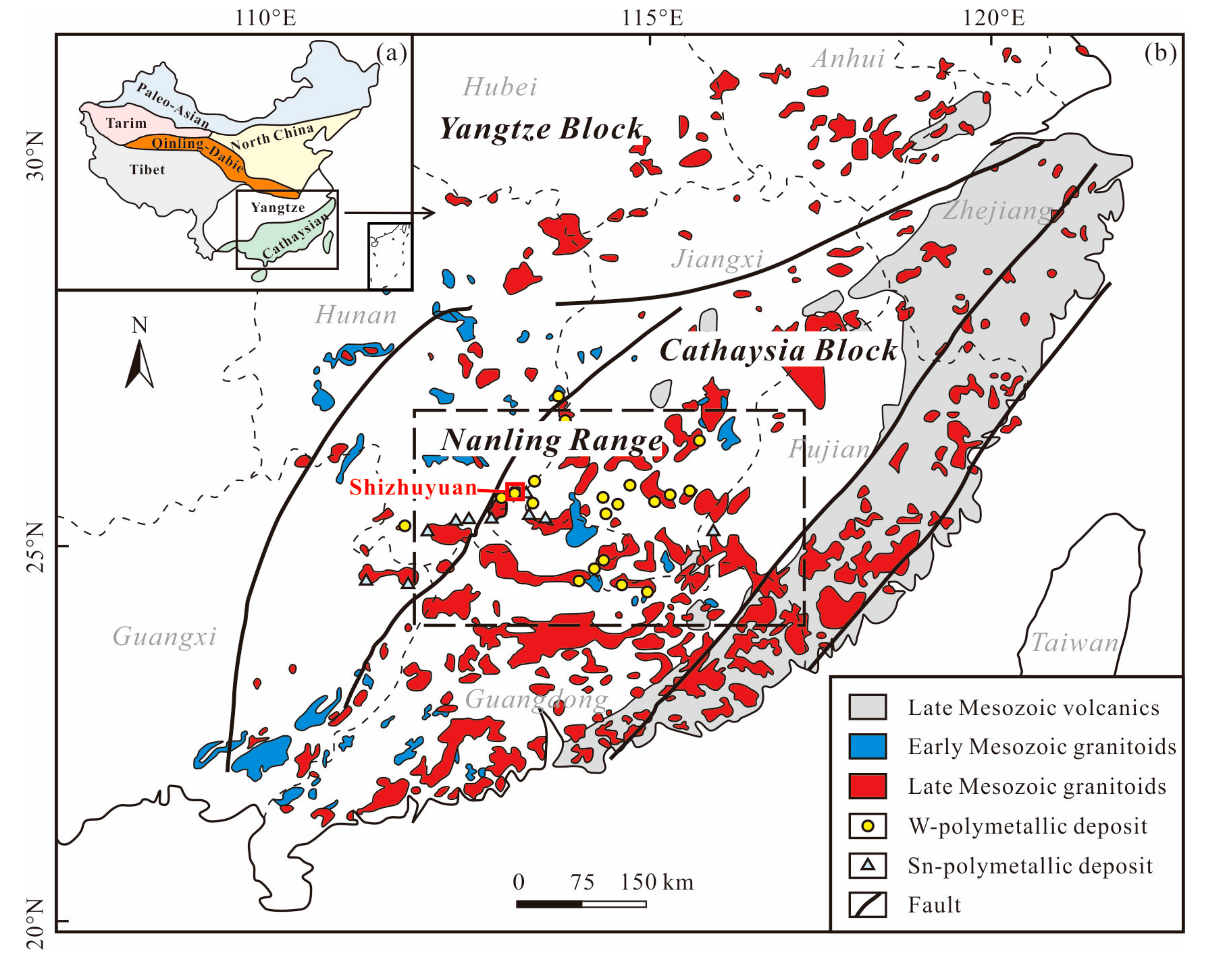
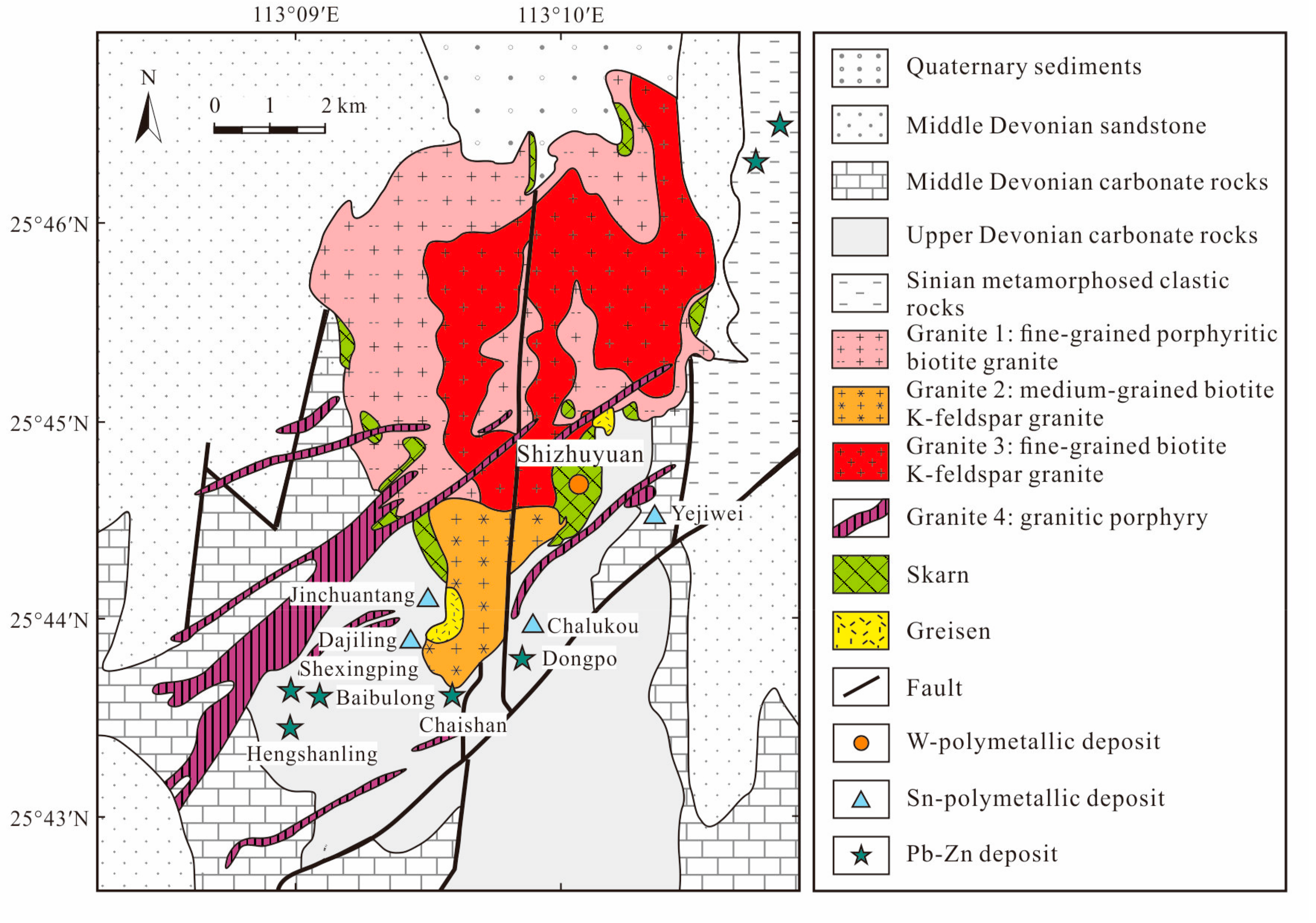
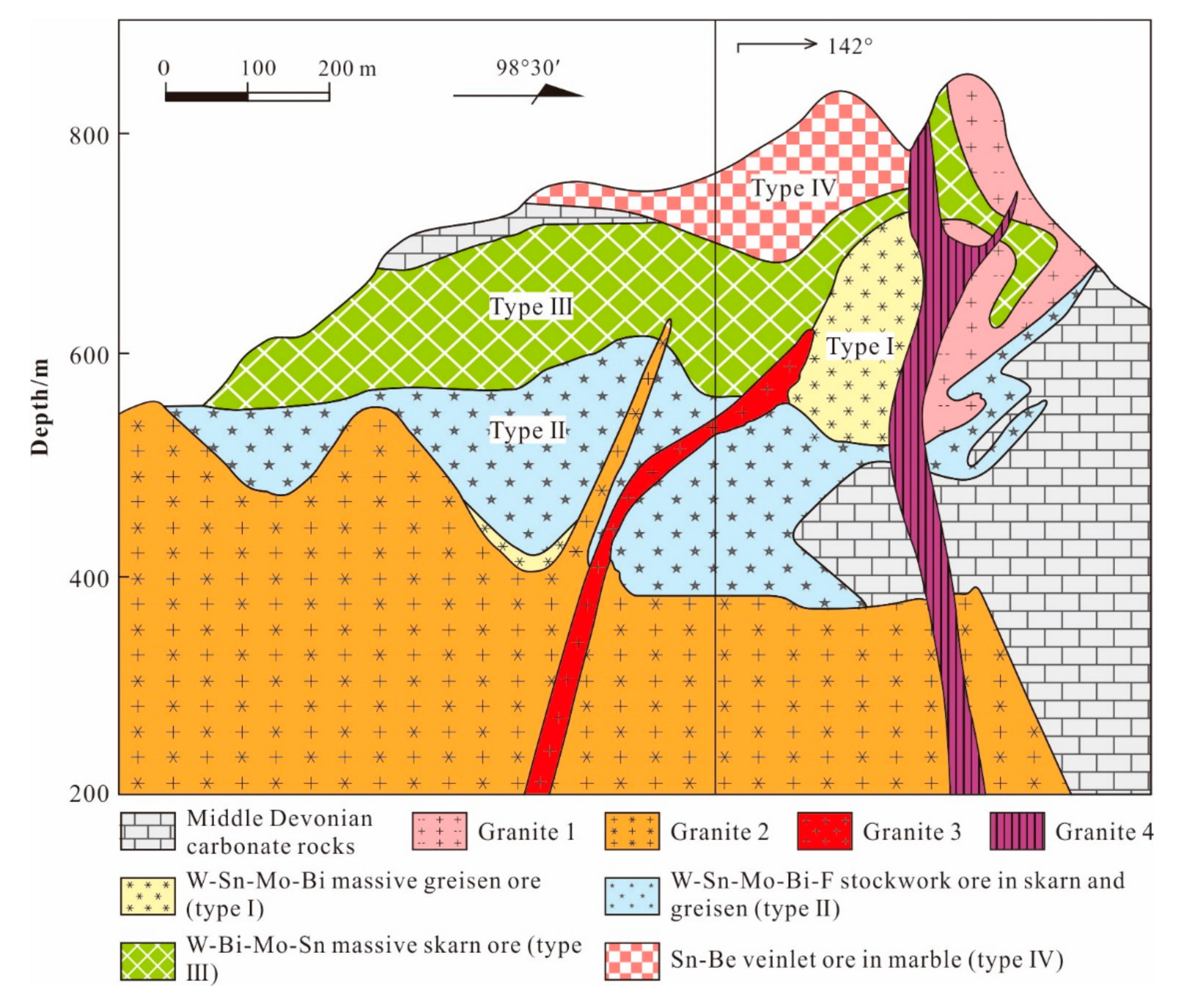
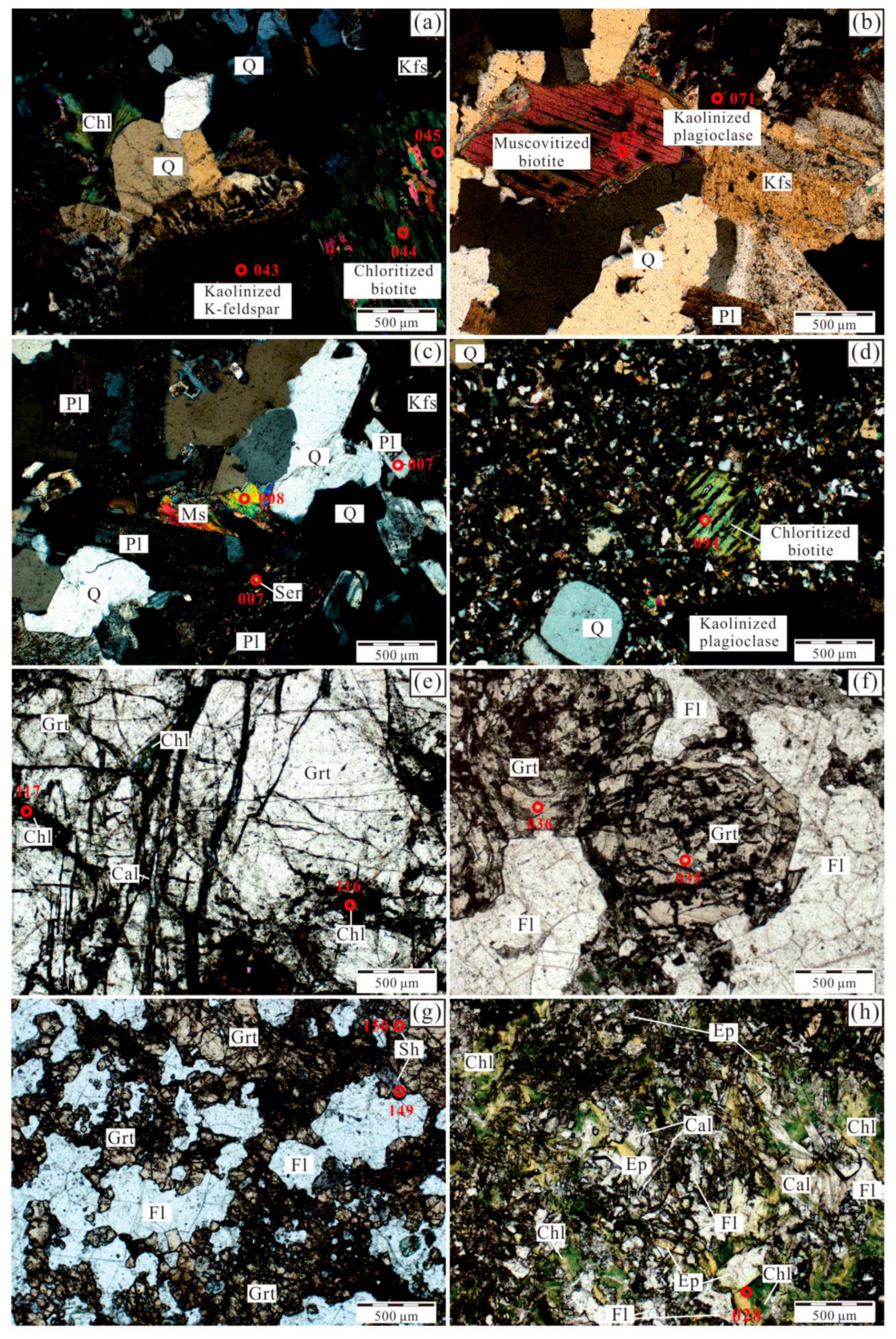
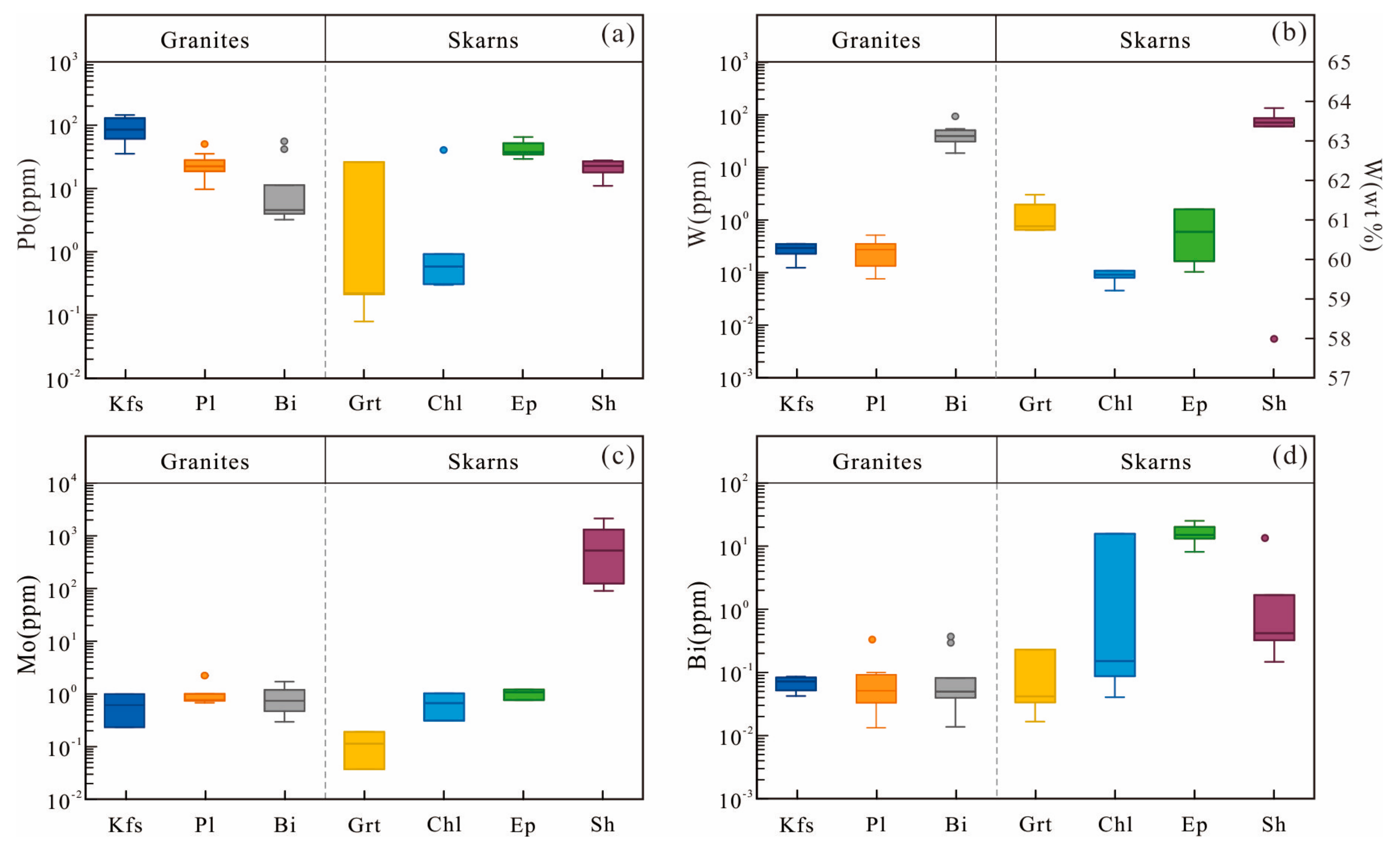
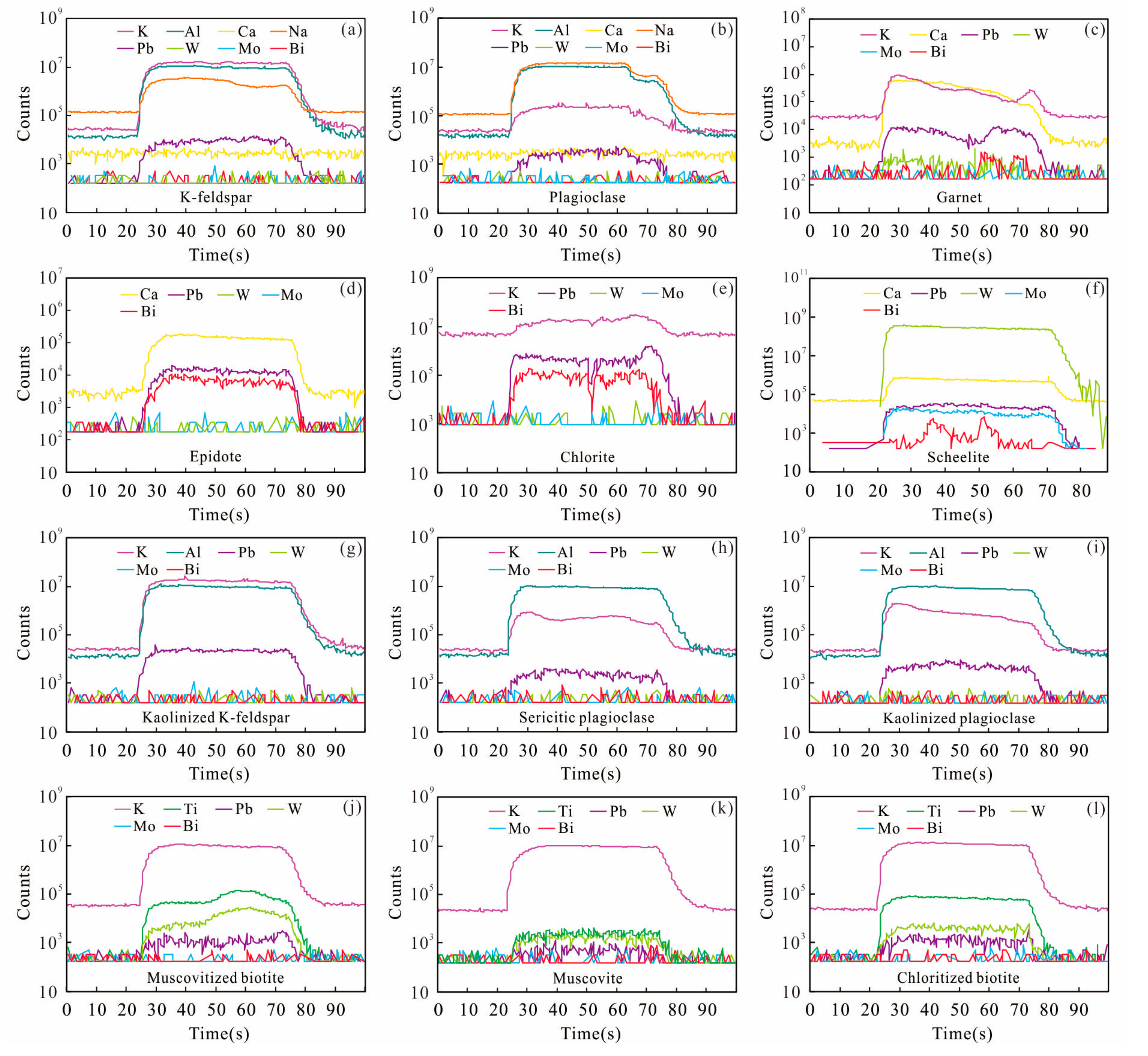

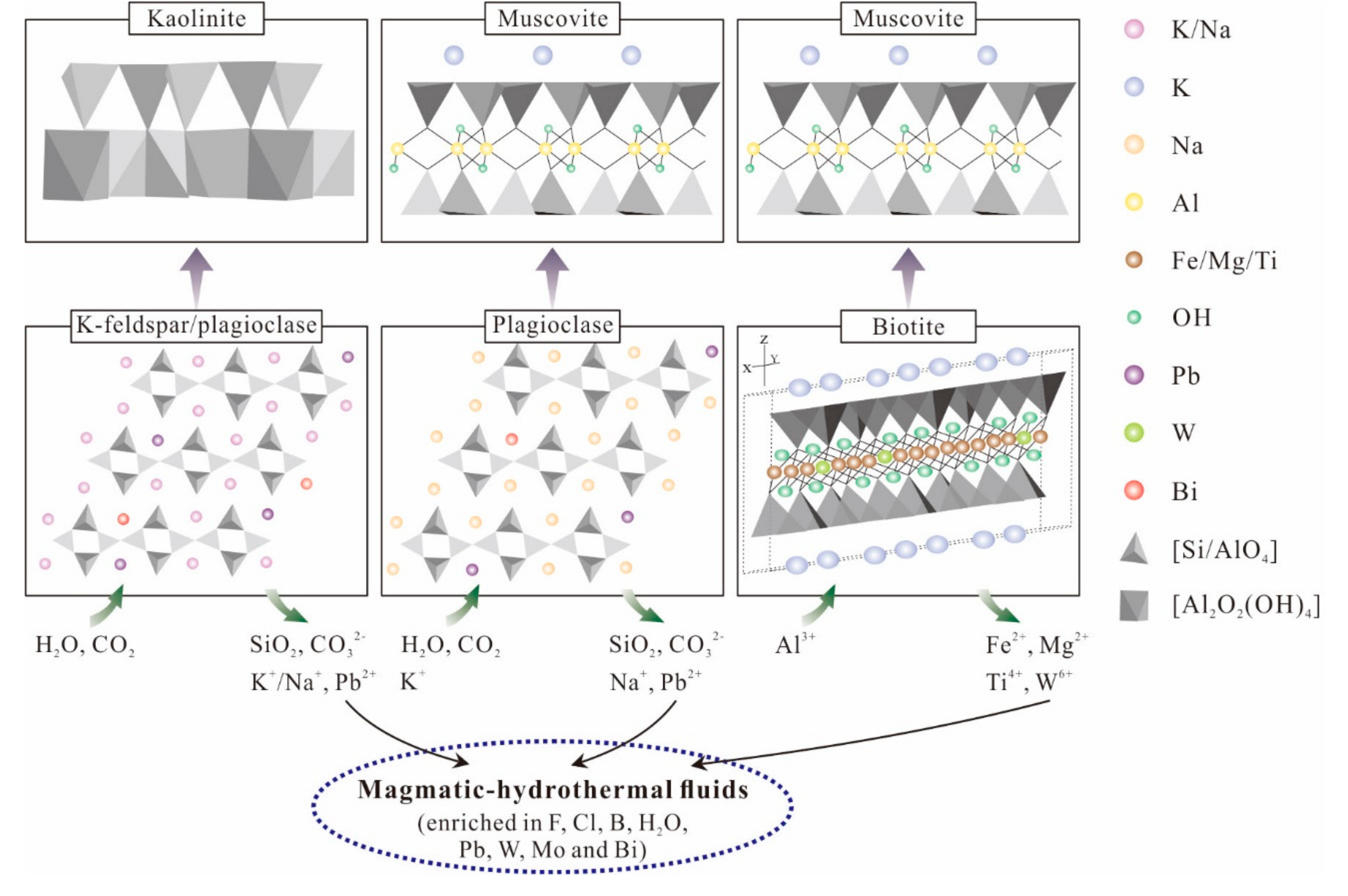
© 2020 by the authors. Licensee MDPI, Basel, Switzerland. This article is an open access article distributed under the terms and conditions of the Creative Commons Attribution (CC BY) license (http://creativecommons.org/licenses/by/4.0/).
Share and Cite
Yuan, J.; Hou, Q.; Yang, Z.; Hu, Z.; Yu, T. LA-ICP-MS Analysis of Minerals from the Shizhuyuan W-Polymetallic Deposit, South China: Implications for Mineralization of Pb, W, Mo and Bi. Minerals 2020, 10, 748. https://doi.org/10.3390/min10090748
Yuan J, Hou Q, Yang Z, Hu Z, Yu T. LA-ICP-MS Analysis of Minerals from the Shizhuyuan W-Polymetallic Deposit, South China: Implications for Mineralization of Pb, W, Mo and Bi. Minerals. 2020; 10(9):748. https://doi.org/10.3390/min10090748
Chicago/Turabian StyleYuan, Jiaxin, Qingye Hou, Zhongfang Yang, Zhaochu Hu, and Tao Yu. 2020. "LA-ICP-MS Analysis of Minerals from the Shizhuyuan W-Polymetallic Deposit, South China: Implications for Mineralization of Pb, W, Mo and Bi" Minerals 10, no. 9: 748. https://doi.org/10.3390/min10090748




